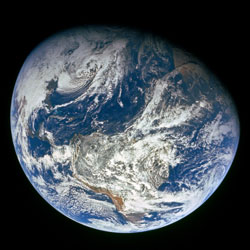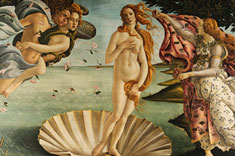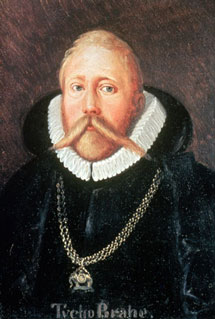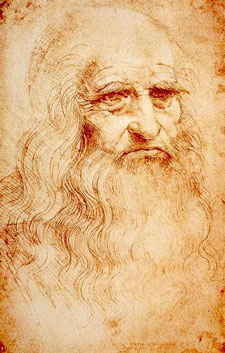Leonardo da Vinci and the Renaissance
The ideal Renaissance man was well versed in many different areas of knowledge. One such man was the artist Leonardo Da Vinci (1452-1519), who was born in Vinci, a town near Florence. Leonardo, who today is considered to be the founder of High Renaissance style, was an artist, architect, inventor, engineer and scientist.
For Leonardo, painting was a study of nature - Leonardo’s work as an artist was thus inextricably linked to his studies of subjects like technology, wave movements, rock formations, and the human body.
Perspective and mathematical beauty
It is said that the language of physics is mathematics. Similarly, artists and architects have used mathematics to create their works using harmonic proportions since antiquity. This can be seen in the mural The Last Supper (1595-98), in which the linear perspective is clearly highlighted by the room’s lines and the vanishing point behind the head of Christ.

The tempera mural Il Cenacolo or L'Ultima Cena (The Last Supper), which measures 4,6 x 8,8 meters, is in the Santa Maria delle Grazie Convent in Milan, in a room that used to be the convent’s refectory (dining room). One of Leonardo’s experiments - in this case with the binding agent for the paint - led to The Last Supper beginning to deteriorate shortly after its completion.
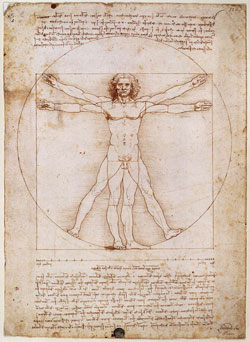
Homo ad Circulum (Vitruvian Man) from around 1490. In this drawing Leonardo examines the Roman architect Vitruvius' theory that the human body can fit into a circle and a square. Leonardo adjusted Vitruvius' measurements and went a step further by also examining the human body in motion.
Leonardo spent a long time trying to paint the The Last Supper - apparently, after having painted a part of the mural, he would take up to several days to reflect on his next brushstroke. The picture is both powerful and gentle at the same time. The colours are pastels, the composition is harmonious, but the scene is dramatic and all of the figures are in motion. The motif shows the moment after Jesus told his disciples that one of them would betray him. According to Leonardo, one had to familiarize oneself with the figure one wanted to paint and think from his or her position.While the painting has a strong focus on people, emphasis is also placed on forms and proportions - both through linear perspective and by the many geometric shapes that the space contains.
Another picture where man and mathematics meet is the famous Vitruvian Man, where man is literally set into a mathematical framework. The drawing is often seen as the epitome of Renaissance humanism - for the Renaissance man, the world was a cosmos, a harmonious, orderly whole. Man was, as created in God’s image, a part of this whole.
The scientific illustration
In 1496, while Leonardo was working on The Last Supper, he met the monk Luca Pacioli (1445-1517), who taught Leonardo mathematics. Mathematics, Leonardo believed, was the driving force in nature.

Luca Pacioli (front) is seen here with a student. The portrait is by Jacobo de' Barberi from around 1496.
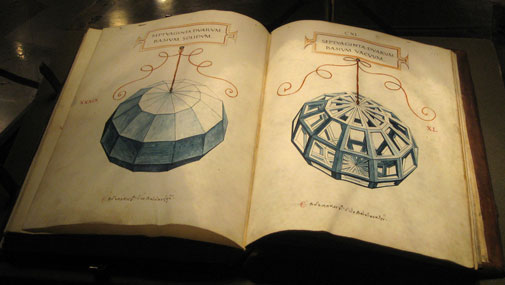
Leonardo illustrated Friar Luca Pacioli’s book De divina proportione (around 1497), which, among other things, discusses the golden ratio.
Renaissance artists sought to paint a naturalist representation of an idealised reality. Leonardo believed that the more a painting resembled reality, the more beautiful it was. This naturalistic style is important in relation to the history of science, because illustrations of inventions or discoveries - before the invention of photography, was necessary to pass on knowledge.
Leonardo’s inventions
Many of Leonardo’s inventions were in use in his time, and his services were coveted by princes who wanted him to invent war machines so that they could defeat their enemies. Other inventions by Leonardo predicted or laid the foundation for discoveries that would be realised hundreds of years later.
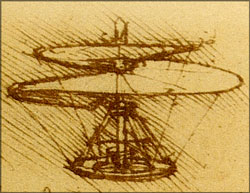
"Aerial screw" from around 1480 (manuscript B, folio 83v). The aerial screw’s spiral shaped sail should be 10 meters in diameter and is operated by hand. The idea was that the machine would rise up when the air was compressed during rotation. The notes seen around the invention are mirrored (see enlarged image) - Leonardo frequently wrote from right to left so many of his notes can only be read through a mirror.
Leonardo spent years studying insects and birds in order to discover the key to their ability to fly as he was sure that one day it would be possible for man to do the same. He invented artificial wings, a flying machine that could be fastened to the body, and this screw-like flying mechanism was the first tentative step towards the invention of the helicopter.
Leonardo put forward many theories and stands behind a host of fanciful inventions - some worked, others did not. But most important about Leonardo as a scientist was perhaps his curiosity about all phenomena around him, his systematic way of examining his questions, and that he was skeptical of ‘truths’ many of his contemporaries took for granted.
Leonardo and astronomy
Just as Leonardo contributed to science, he believed that science was an important foundation for art - to understand what you painted down to the tiniest detail. This led Leonardo to study fetal development in the womb, the laws behind water currents and wave movements, plant and tree growth and to dissect more than 30 corpses, just to mention a few examples.
Leonardo did not accept doctrines uncritically - he asked questions and studied them systematically with an open mind. For example, he noted, at a time when it was believed that the moon shone by itself, that the moon instead reflects the light of the sun. However, he believed this had to be because the moon was covered by water.
|
In addition, he thought about what it would be like if you saw the earth from the moon - that the earth would look like the moon does from the earth and that the sea would reflect the sun’s light more strongly than land. Clouds reflect sunlight the most strongly, but here Leonardo is remarkably close the image of the globe we have today, using satellite images or images taken from spacecraft.
| Next >> |
The Renaissance
Science in the Renaissance
Leonardo da Vinci
|

